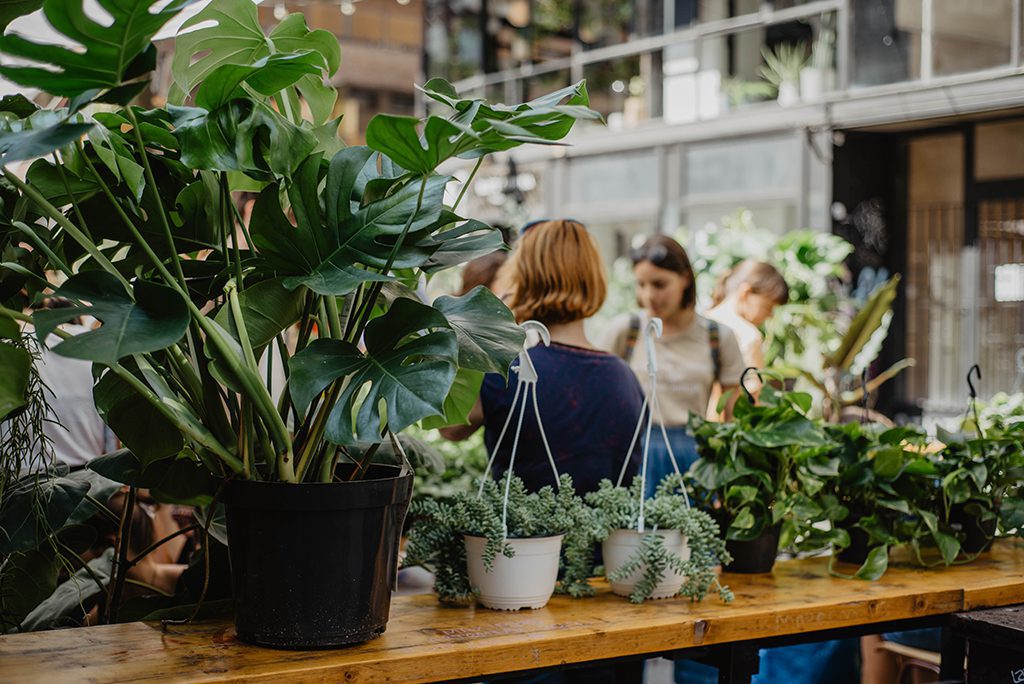
A recent study by the Floral Marketing Fund found that houseplant consumers are willing to pay more for quality plants.
Houseplants have plenty of appeal. They make people happy. They beautify homes. And for the retail florist, they can provide high profit margins.
A recent study by the Floral Marketing Fund found that consumers who bought houseplants during the pandemic were willing to pay a higher-than-average price for houseplants. This includes flowering and foliage plants, succulents, ferns, air plants and more.
“In 2021, houseplant purchasers said they were willing — and wanted — to pay price premiums for quality houseplants that are attractive and augment their living spaces,” says Melinda Knuth, Ph. D., of North Carolina State University, one of the researchers behind the Consumer Houseplant Purchasing study. “This group of plant buyers also said that they were willing to pay more for houseplants that were beneficial to their physical and mental health.”
The study highlights emerging trends in the plant market, including plant buyer demographics, where consumers shop for houseplants, what types of plants shoppers are buying and insights into the prices consumers are willing to pay for houseplants. The study was cosponsored by Altman Plants, Costa Farms, Green Circle Growers, Hortica and Metrolina Greenhouses.
How Do Your Prices Measure Up?
With each houseplant category, the study asked consumers to rate four prices:
- too cheap (a plant priced so low that it makes the customer question its quality)
- bargain (a great buy for the money)
- getting expensive (the customer might still consider the plant, even though it’s getting expensive)
- too expensive (this plant is so expensive the customer wouldn’t consider buying it)
The study asked consumers to choose which price best fit each plant they saw in the study.
For instance, for a small flowering houseplant, the “too cheap price” was $10.30; the “bargain price” was $20.40; the “getting expensive” price was $37.70; and “too expensive” price was $65.70. For a small succulent, the same categories ranged from too cheap at $6.50, to bargain at $15.70, to getting expensive at $30.90, to too expensive at $50.10.
Should You Charge More?
“The industry is leaving money on the table, so to speak,” says Hayk Khachatryan, Ph.D., of Mid-Florida Research and Education Center at the University of Florida, a researcher with the study. “Most of the houseplant purchasers indicated a general willingness to pay higher prices than industry firms have been charging at retail — and sometimes substantially higher.”
This indicates that price elasticity appears favorable with houseplants. Knowing how far prices can increase before demand is affected remains to be seen — and may vary by market.
“In some of our other studies we found that plants are sensitive to price changes,” Khachatryan says. “The key is to aim for price points that consumers think are do-able for them.”
He suggests using the study’s extensive list of price ranges, which are categorized by plant species, as boundaries. “It’s really hard to know the price sensitivity of plants. We’re not saying to use these exact prices but view them as a starting point for discussion.”
The study’s researchers caution that the prices consumers reported they were willing to pay in the study may not match what they’d actually pay because they are being asked a hypothetical question.
Hone Your Price Points
The take-home message from houseplant purchasing patterns is that pricing plants doesn’t follow a cookie cutter approach. It will vary by market, region and, of course, size and type of plant. Here are a few guidelines to keep in mind as you consider your plant pricing strategy.
Price is important. “For the entire market, I do believe that price is near the top priority when making a plant purchase,” Khachatryan says. “It’s subconscious. People always look at the ratio of what they’re getting for the price. They’re always comparing prices mentally.” He suggests that the greatest influencers on plant buying decisions are plant quality, price and selection or variety. To hone your price tags to deliver a profit, don’t forget to focus on houseplant quality and selection, too.
Examine value carefully. According to the study, consumers decide where to buy houseplants based on convenient location, customer service and product selection. While you may not be able to move your shop, you can shine in service and selection. These two attributes can enhance the value of your shop’s houseplants in the minds of your customers. As consumers compare prices, they’ll factor these attributes into the equation. It can add up to sales for you.
Containers count. Khachatryan stresses that it’s important to consider what consumers look for in terms of product experience. “What do customers value more? That’s what you want to deliver. The study shows that 37 percent of houseplant buyers think that a houseplant container is important. The pot attributes they consider most are style, color, water-storing and shape,” he says. Container texture, material, sustainability, and brand were less important to consumers.
Low prices have a place. Some customers will always respond to lower prices. It might be they’re new to the hobby and need an entry-level price point to pick up that first houseplant. Or it might be their budget has tightened in light of inflation or employment changes. “Using a dynamic pricing strategy might prove useful to address the different levels of consumer price elasticity in the marketplace,” Khachatryan says.
Julie Martens Forney is a contributing writer for the Society of American Florists.
The Society of American Florists’ learning hub, Career Connections, has a new collection of resources to help you grow your business with houseplants, including:

